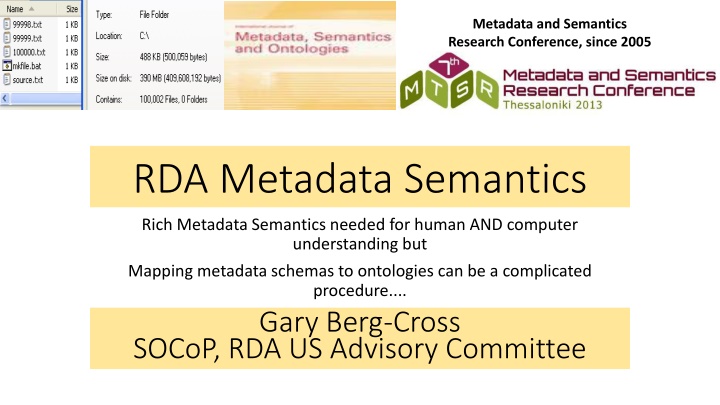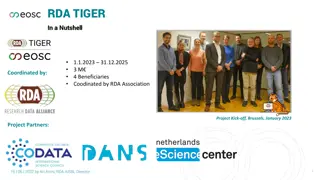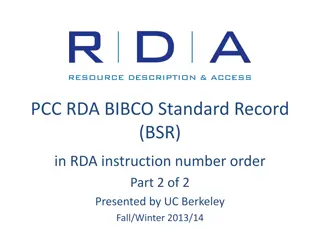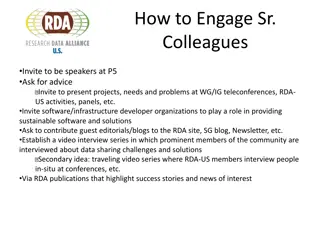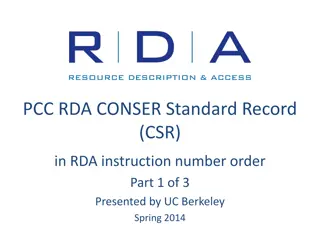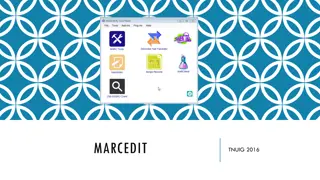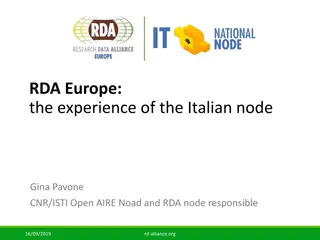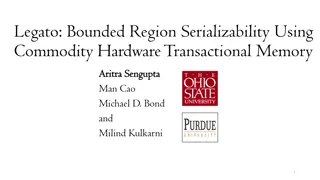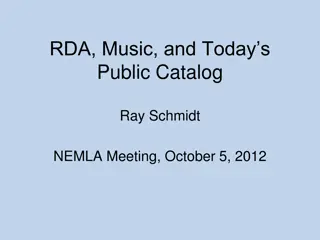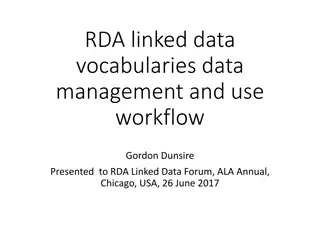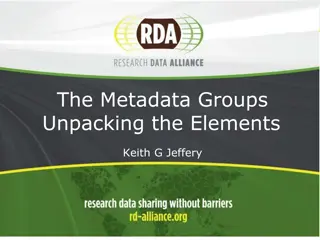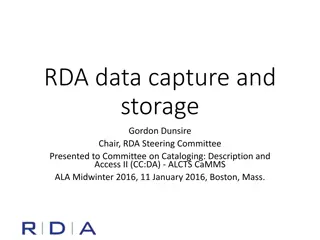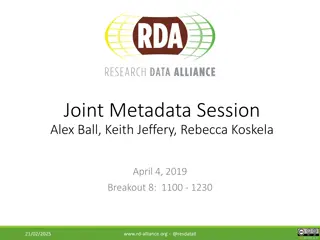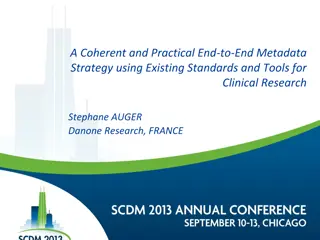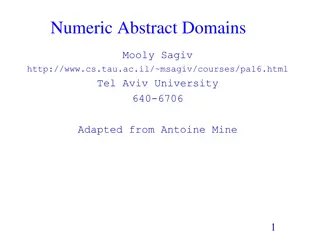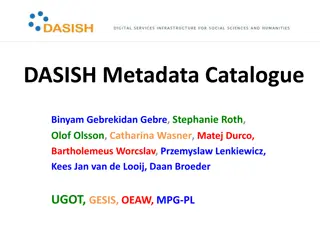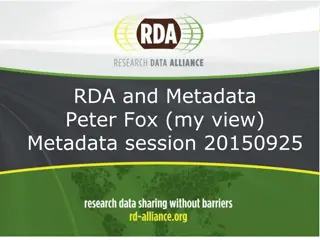RDA Metadata Semantics Research Conference
The evolution of metadata standards and the need for rich metadata semantics in human and computer interactions, including discussions on mapping metadata schemas to ontologies and the readiness for widespread use. Topics cover various aspects of metadata, semantic annotation, modular theory of metadata, and standardization in specific domains."
Download Presentation

Please find below an Image/Link to download the presentation.
The content on the website is provided AS IS for your information and personal use only. It may not be sold, licensed, or shared on other websites without obtaining consent from the author.If you encounter any issues during the download, it is possible that the publisher has removed the file from their server.
You are allowed to download the files provided on this website for personal or commercial use, subject to the condition that they are used lawfully. All files are the property of their respective owners.
The content on the website is provided AS IS for your information and personal use only. It may not be sold, licensed, or shared on other websites without obtaining consent from the author.
E N D
Presentation Transcript
Metadata and Semantics Research Conference, since 2005 RDA Metadata Semantics Rich Metadata Semantics needed for human AND computer understanding but Mapping metadata schemas to ontologies can be a complicated procedure.... Gary Berg-Cross SOCoP, RDA US Advisory Committee
Outline of Topics 1. Metadata- many Standards and some Ambitious MD Requirements 2. RDA Metadata-Semantic Discussions & Background 1. Rich Metadata Semantics needed for human AND computer understanding 2. Semantic approaches needed for MD schemas 1. Adding formal semantics to metadata schemas for discovery, and queries, mediation/linking and reasoning use an be a complicated procedure.... 3. Illustrating 2 Semantic approaches 1. Semantic Annotation 2. Example of an Ontological Schema 4. Are we ready for metadata semantics to be widely used? Where are the opportunities? Can we agree on common or domain principles (like modularity or building blocks) or some formal semantic requirements?
Metadata & Standards Evolution from file system names/types & Describing DB Fields to MD Schemas for Exchange Dublin Core attaching categorical tags and descriptions via a MD schema Attempt to make data more human understandable capture agreed upon MD that affords understanding The MD effort now requires many interacting pieces including Metadata Application Profiles and Workflow like entities
Strategy of Modular Theory of General and Domain Specific MD (and Ontologies) Trans-Domain (General Consensus) Metadata ID, time.... ISO MD_Keywords: Discipline, Place, Stratum, Temporal, Theme? Harmonized And Packaged Together Support Interoperabiity Independent?? Standardized Geo-specific metadata Standardized BioMed-specific metadata Standardized EarthScience- specific metadata Modules should be easier to create, validate, understand and maintain They may be substituted for and used and reused for composition
There are specific standards in domains [ISO 19115:2003] Geographic information -- Metadata [ISO 19115-2:2009] Geographic information -- Metadata -- Part 2: Extensions for imagery and gridded data General MD Other MD OGC Object Types axis axisDirection datum dataType derivedCRSType documentType ellipsoid featureType group Meaning.... In OGC s O&M model Earth Observations generate products that have metadata. These are organized into a metadata profile organized as a schema Support bridging heterogeneity To achieve interoperability Support data integration.
Some Metadata Challenges (Earth Science from Ilya Zaslavsky, CINERGI* pipeline) Common deficiencies in existing metadata descriptions: 1. Different metadata models and profiles, 1. Different details of requirements mandatory and optional fields (Dublin Core vs ISO) 2. Different meaning of fields and initial purpose/emphasis of data collection 3. Different local interpretations of how these fields should be filled out (eg authors and contacts are often mixed up). 2. Different classifications of resource types 1. Common resource types are: Organization, Webpage, Collection, Dataset (EPOS -Users, SW services, computing services) 3. Title may be non-descriptive 1. insufficiently unique ( Roads ) 2. meaningful, but opaque naming patterns (eg AXXX34nn1 ) 4. Keywords 1. may be missing or may be too specific to domain 2. may lack references to a thesaurus/CV or are freeform text 5. Info missing such as Abstract, Contact saying call , location, time without reference, wrong URL 6. Grouping: a range of metadata records from a single source may be very similar (only differ in one parameter e.g. location) they may be better discovered as a group of records 7. Duplicates Several metadata records from different catalogs may point to the same physical dataset (or have overlapping susbsets of distributions) Provenance Issue? ...... * Community Inventory of EarthCube Resources for Geosciences Interoperability (http://workspace.earthcube.org/cinergi)
Broad View of Metadata (Schema) Status & Argument for More Semantics Richness issue Even when done well simple annotations and structured metadata are not rich enough to support ad hoc use & certainly not reasoning based on meaning. There are many MD schemas and a broad challenge is to link/integrate them. Metadata schemas are created for resources identification and description and - most of the times - they do not express rich semantics. Even though the meaning of the metadata information can be processed by humans and its relationship to the described resource can be understood, for machine processing the actual relationships are frequently not obvious. In contrast to metadata schemas, ontologies provide rich constructs to express the meaning of data Stasinopoulou, Thomais, et al. "Ontology-based metadata integration in the cultural heritage domain." Asian Digital Libraries. Looking Back 10 Years and Forging New Frontiers. Springer Berlin Heidelberg, 2007. 165-175.
RDA Background & Outreach on Semantics A growing interest in the topic of semantic interoperability. The centrality of semantic issues was, for example, noted following the 1st Plenary. Semantic issues and technologies are already part of the discussion on the RDA Forum. Research communities need to adopt and deploy technologies that help them get the most from their data, understand context, and infer meaning. The semantic web community has much to contribute to an enabling global infrastructure and it would be great to see greater involvement in the RDA. Fran Berman (Professor of Computer Science, RPI, Chair of the Research Data Alliance/U.S.) RDA should take on this issue but how? And who will participate?
RDA Metadata and Semantics Intersect Data Foundations and Terminology (WG & IG) Data in Context IG Data Fabric IG Geospatial IG Marine Data Harmonization IG ( ISO 19115 etc.) Broker IG Research Data Provenance....... Semantic Interoperability BoF at RDA P3 3 Presentations to illustrate key concepts of SI & use of ontologies- Gary Berg-Cross & Yann Le Franc Discussed Ontology Design Patterns and Lightweight methods EUON effort What is a quality ontology? 1st European Ontology Network (EUON) Workshop co-located at P4 http://www.eudat.eu/euon/euon-2014-workshop
The Need for Some Semantics is (somewhat) Understood 1. MD need to be a first class, processable system, like a conceptual model, easier to use, manage and follow efforts to make data more understandable by computers. 2. Semantics helps address what MD annotations mean 1. What the shared meanings are 2. What the assumptions such as relations between MD items are and 3. How links to other data can be included? Restrictive Principles and Foundations of Ontologies and Semantic Grids - Session 48. July 15th, 2009 Oscar Corcho (Universidad Polit cnica de Madrid) http://www.slideshare.net/ISSGC/session-48-principles-of-semantic-metadata-management
How do we add Semantics to MD? Depends on Intended Use : Example of Semantic Annotations (HTML -> RDFa) For data description and context the semantics added can be like a formal, conceptual model For search it can be like a better annotation of keywords using RDF. Start with a collection XHTML attributes in a web page Embed RDF annotations in the web pages using things like DC and FOAF vocabularies easily used for most simple annotations -e.g. Creator, title, contact info Becomes From Introduction to Semantic Technologies, Ontologies and the Semantic Web Aug 2010 #39
Beyond Vocabularies: Good Semantics Needs Appropriate Conceptualization of Properties Connect properties like stream flow, level, pollutants, evapotranspiration etc. in a schema hasLayer .. Density Unit Water Density Grams /cm3 Water Water Body hasDensity Unit hasConstituent hasFeature hasUnit HasFeature IsA hasValue Real Number Area Quantity Chesapeake Bay Area Sq Miles hasQuantity hasUnit For connecting to Chem/BioChem ontologies there might be sub-categories of Physical Features for elements optical, hardness, color See Dumontier Lab ontologies to represent bio-scientific concepts and relations. http://dumontierlab.com/?page=ontologies 12
Ontology Design Patterns (ODPs) of Semantic Trajectory Hydro/Ocean Observations as Annotations ODPs (aka microtheories) small, modular, & coherent schemas. Relatively autonomous but conceivably composable with other schemas. Environmental Observations fit into this schema. Fixes may be hydrometric feature observations & at some PoI (and offset Fix) for some point or period of time denoting important activities Observations including time series sets might be applied to something like streamflow or temperature plots or a pollution plume or data from an ocean glider You may query Schema : Show locations within Gulf of Mexico fishing area with colored dissolved organic matter Hydro Obs/Device Hydro Var & attr/data or value type of Interest Paths & POIs Have Geometries including Polygon Areas Hydro Object or moving device A Geo-Ontology Design Pattern for Semantic Trajectories COSIT 2013: Yingjie Hu et al. 13
Are we ready for metadata semantics to be widely used? How do we bring current MD practice and semantic practice together? What is a practical MD vision of this enhanced MD? Where are the opportunities? E.g. Is semantic annotation the sweet spot? Do we just expand MD tags to semantic annotations and if so how? What about ontology design patterns (ODPs)? Where are they useful? Thoughts on where to add semantics and its technology to MD in the data/MD cycle? How does it affect how data/md repositories function? Some/considerable confusion about how MD should be integrated into information systems. Can we agree on common or domain principles (like modularity or building blocks), practices and tools to employ ?
